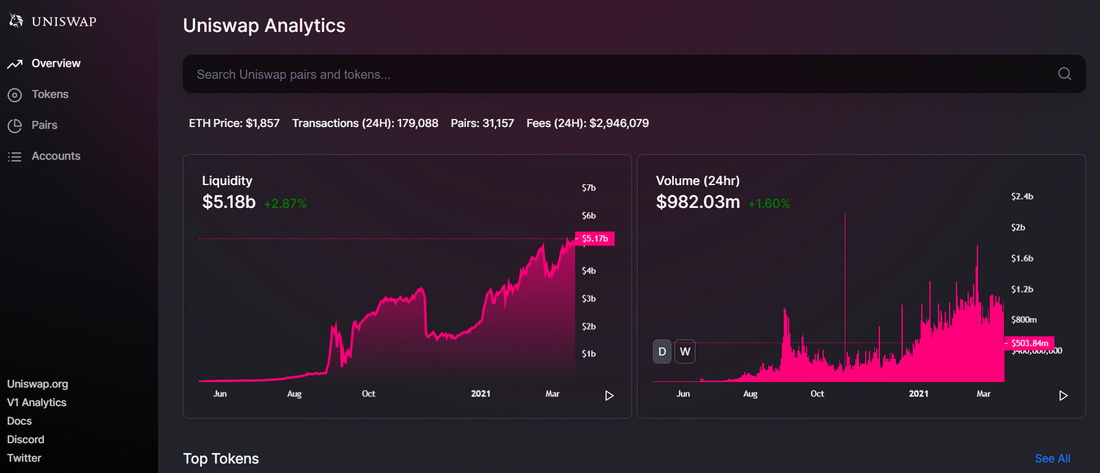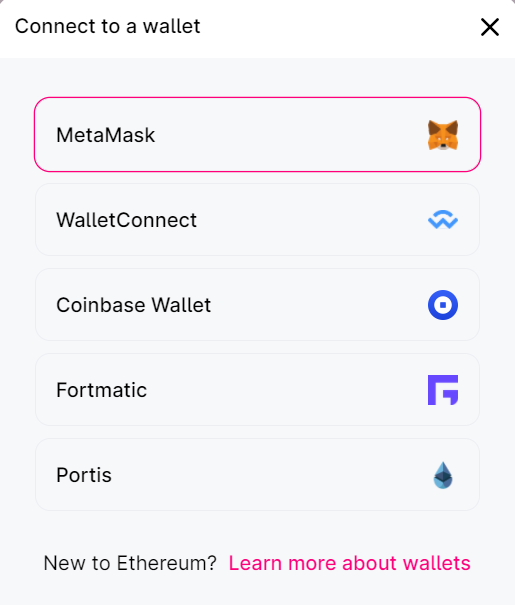 |
Uniswap ReviewExchange
Withdrawal fee: 0.00 Taker fee: 0.30% Maker fee: 0.30% |
Uniswap is a top decentralized non-custodial exchange and automated market maker (AMM) that runs on the Ethereum blockchain. Founded in 2018 by Hayden Adams [LinkedIn], It began to gain major traction in 2020 and has officially taken off in 2021, achieving name brand recognition in the crypto world; it’s home country is in the United States. It currently offers over 2,300 different token pairs and has one of the highest volumes of any DEX on the market.
The protocol allows users to swap between different ERC-20 tokens by simply connecting to an Ethereum wallet – no 3rd parties or middlemen are needed to facilitate transactions. The governance token is UNI, helping power the ecosystem and incentivize the community to participate in decision-making initiatives.
Uniswap has now cemented itself as a strong rival and true threat to its centralized exchange competitors, absorbing tremendous liquidity and attention away from them. Although mostly known as having a simple trading mechanism, there’s much more to this project than meets the eye.
Uniswap Fees
Trading Fees
In order to swap tokens, you will need to pay a 0.3% liquidity provider fee. In addition, with every trade, you will need to pay a certain amount in gas fees – although this is not a fee directly charged by Uniswap, it is an important consideration to keep in mind.
There are no protocol or protocol charge calculation fees yet, however these may be introduced in the future.
Withdrawal Fees
As the transactions are initiated, stored, and approved through an Ethereum web wallet, there will be a certain amount of gas fees you will need to pay in order to withdraw any digital token from the wallet. These fees may vary depending on the cost of gas on that specific day/time.
Trading View
The beauty of Uniswap exchange is the extremely simple and easy-to-use app interface. You can either swap, provide liquidity in a pool, vote, or view analytics charts for liquidity and price information.

Uniswap (v1) vs. Uniswap (v2)
While Uniswap v2 is an upgrade to v1, they still coexist together and can be used separately. Uniswap v1 was the original protocol in its simplest form. In v1, you are only able to swap between Ethereum and another ERC20 token, whereas v2 uses WETH to allow you to swap from any token to another.
The price feeds in v1 aren’t decentralized and can be distorted, but v2 solves this issue with an oracle system to display accurate information and keep the protocol safer. Additionally, v2 works with other ERC tokens, fixes the v1 issue of consuming all gas on failed transactions, and more.
Uniswap (v3)
V3 is the latest version of Uniswap, and was one of the most highly-anticipated updates to the protocol yet! It offers Concentrated Liquidity providing more efficiencies for traders and a strong ecosystem overall.
For swapping, the interface directs trade via V2 and will provide you with a notification if there’s a better rate on V2, allowing users to get the best prices.
For liquidity providers, there’s now a migration portal for V2 and SushiSwap users to transfer their tokens to V3. Pools now support deposits with various fee tiers and concentrated liquidity ranges. Every position in pools is represented as an NFT with amazing artwork!
In essence, this new upgrade makes the entire ecosystem and protocol much more capital efficient compared to V2. V2 will still be active for those wishing to use it.
Swap
The swapping interface is the most heavily utilized one, and what made Uniswap exchange famous. The process is simple – select the token you want to sell under From and the one you want to buy under To. Once you’ve selected the amount, simply click Swap and confirm the transaction on your Ethereum web wallet. That’s all it takes!

Flash Swaps
Flash Swaps let you withdraw the maximum amount of liquidity of any token on Uniswap exchange for free, if (when the transaction is complete) you pay for the withdrawn ERC20 tokens with the same pool/pair token or return the tokens you withdrew.
If you can’t pay for or return the tokens, the flash swap transaction will not be successful. The only fee you need to pay is a small protocol fee.
Supported Countries and Cryptos
Uniswap exchange is located in the United States, however from a user perspective it is decentralized and automated, so anyone in the world can use it as long as they have access to the internet and an Ethereum wallet. Therefore, it is the freest type of exchange on the market and embodies the true nature and purpose of cryptocurrency.
As mentioned earlier, Uniswap supports over 2,300 different token pairs on the Ethereum blockchain; however, tokens that aren’t built on Ethereum are not supported. Still, there is a wide range of tokens to choose from which can also be bridged to other chains to swap for non-ERC20 tokens if needed.
Deposit and Withdrawal Methods
Depositing and withdrawing is easy. Uniswap exchange doesn’t store your tokens but helps facilitate transactions through your Ethereum wallet. So, any deposits or withdrawals would be made crypto-to-crypto via your wallet, that would then connect to Uniswap exchange in order to execute a transaction.
Uniswap (UNI) Token
UNI is Uniswap’s governance/protocol token, used to help facilitate and power the ecosystem. 60% of the totally UNI genesis supply is distributed to community members, and 15% of that supply has been given to existing users.
UNI is now available on most major exchanges and is available through four different liquidity pools on Uniswap. UNI holders have voting rights and can influence certain actions or decisions for the protocol.
In September 2020, Uniswap airdropped 400 UNI tokens (worth around $1,200 at the time) to any existing Ethereum addresses that had interacted or facilitated a transaction on Uniswap exchange. This generated tremendous buzz and got the community roaring, migrating even more users to the protocol and rewarding the early adopters.
Liquidity Provider Rewards
Users have the ability to become liquidity providers – by doing so, you can earn 0.3% on all trades proportional to your overall share of the pool. You will be able to claim any earned fees when you decide to withdraw your tokens from the pool.
When you deposit ERC20 tokens into the pool, you will need to choose your pair and deposit an equal amount of both tokens respective to their current market prices.
Uniswap Governance
As previously mentioned, users who hold UNI tokens are able to vote and submit changes to the protocol; having UNI entitles you to voting shares in Uniswap governance. This allows the community to make decisions based on a majority vote, and was put in place to maintain the decentralized nature of the protocol.
Below is an example of some of the proposals that have been approved and turned down:

API
Uniswap exchange has a subgraph that organizes data pulled from its contracts, such as pair, token, transaction, and more information. This subgraph updates any time a transaction is made and is powered by The Graph.
Entities represent the data that can be queried, and the subgraph itself can be queried in order to obtain information from Uniswap. Uniswap v2 and v1 have their own respective subgraphs. The API is quite advanced and helps feed all of this necessary information.
How to use Uniswap Exchange
Since it is a decentralized protocol, you don’t necessarily need to “sign up” for an account, as no official accounts exist. Getting started with Uniswap exchange is easy – the main thing you will need is a web wallet to connect to the protocol to begin trading. The top recommended web wallets are:
- MetaMask
- Coinbase Wallet
- WalletConnect
- Fortmatic
- Portis

Once you have a wallet, navigate to the Uniswap interface and click Connect to a wallet in the top right hand corner of the screen. You will then be prompted to unlock your wallet by entering your password – and voila! You are now connected to Uniswap exchange and can begin trading.
In order to try out any of the other interfaces/pages (liquidity pools and voting), these can be found on the top left hand side of the app homepage, where you will again need to use your wallet.
Security
Uniswap v2 was audited by a team of six engineers – the components of the smart contracts were reviewed and verified to ensure the proper security measures were in place; you can read a report of the full details of the audit on Uniswap’s website.
It also has an ongoing bug bounty program, where community members test and debug the smart contracts to mitigate the potential for user issues when using the platform. Overall, there are constant checks to ensure the network is always running smoothly, and the community gets involved where needed.
Conclusion
Over the last few years, Uniswap has become one of the most utilized exchanges worldwide in the crypto space due to its decentralized nature and large availability of tokens. It’s also easy for beginners to grasp the fundamentals of how to use it, as the swap interface is as clear as day. We’ve assessed the most critical pros and cons of the proctol, which are as follows:
Pros
- Completely decentralized, where anyone across the world can use it with no restrictions
- High liquidity and plenty of token pairs to choose from
- Easy-to-use; get started in minutes with no KYC or verification
- Earn rewards by providing liquidity
- Ability to vote on initiatives for the protocol if you hold UNI tokens
Cons
- High gas fees to make transactions and withdraw tokens (although this is not only related to Uniswap exchange, as it is a current issue for all Ethereum-based DEXes)
- Limited to tokens built on Ethereum only
- The swapping interface doesn’t allow you to view real-time charts or place limit orders (less advanced trading mechanisms)





